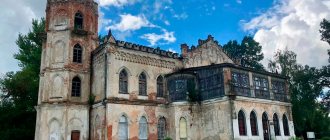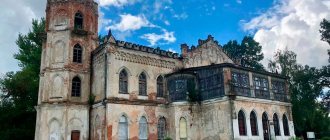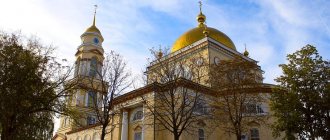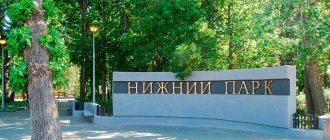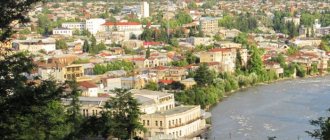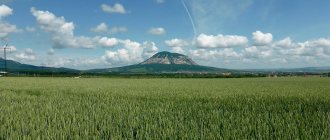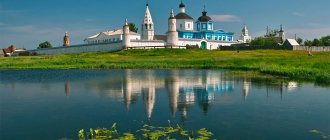The first and one of the main questions that arise when planning a vacation in Tbilisi is what to visit, what attractions to see, where to go. Specifically, to answer these questions, we have compiled a guide to the sights of Tbilisi with photos and descriptions. It includes all the most important and interesting sights of the capital that you need to see first when arriving in the city. As a result, the TOP 30 attractions of Tbilisi were released, divided by importance and grouped by the number of days available. There are routes for one day, 2-3 days and even a week. In addition to descriptions and photographs, the guide contains opening hours, coordinates and a map of attractions in Russian with addresses.
TOP 10 attractions of Tbilisi
We have compiled a list of the best attractions in Tbilisi that you must see within 1 day of arriving in the city. You can visit this top 10 places on the first day or create a route for 2 days. Despite their apparent proximity, they are not so easy to find or you can easily get lost among the streets. We definitely advise you to book a tour for your first and most important acquaintance with Tbilisi and its attractions. After all, Tiflis is permeated with a rich history and interesting legends, and without them you will simply walk along the main streets without knowing its secrets and soul.
Old town of Tbilisi
The Old Town is the historical center of Tbilisi, where most of the main attractions and buildings of the capital are concentrated. It is in this place that you can feel and touch the flavor of the city. Walk along the narrow streets paved with paving stones and enjoy the beauty of the carved balconies.
- Old Town coordinates: 41.689173, 44.807943
Narikala Fortress
The main fortress of the city, which can be seen from anywhere in the old city. It was located high on the rock of the Sololaki ridge. Narikala is so ancient that no one knows by whom or exactly when it was built. It is generally accepted that it is the same age as Tbilisi and they have the same historical line, but there is also an assumption that the fortress existed even before the founding of the city and was called Shuris-tsikhe. Its walls have always served exclusively for defense. Narikala has undergone many transformations throughout history.
According to one version, the fortress received its current name during the invasion of the Mongols, who called the Narinkala fortress “Narin-kala-small fortress.” Later, a temple appears on the territory of the fortress, and the walls descend into the city, becoming higher and higher. In some places in Tbilisi, underground paths are made leading directly to Narikala, so that during the siege of the city, you can safely reach the fortified fortress. Today, the fortress has only its former grandeur and consists of only restored walls, which were badly damaged by both the earthquake and the explosion of the gunpowder warehouse. For guests of the country, the fortress serves as an excellent observation deck with a beautiful view of the city. The most convenient way to get to Narikala is by cable car from Rike Park; you can also climb the paving stones from Meydan Square and the stairs from the botanical garden.
- Narikaly fortress coordinates: 41.687902, 44.809259
- Opening hours: 24 hours a day.
Mother of Georgia
The symbol of the Georgian people and the visiting card of Tbilisi is the Mother of Georgia monument. A huge woman looks at Tbilisi from Sololaki Mountain with a bowl and a sword in her hands. In her left hand she holds a bowl, which at a Georgian feast serves as a vessel for pouring wine and is generally a symbol of hospitality. In his right hand, grandfather Kartli holds a sword as a symbol of readiness to fight with those who came as an enemy. In general, the monument conveys the mentality of the Georgian people: they can welcome a guest warmly, but they will meet an enemy with a sword.
- Mother of Georgia coordinates: 41.688159, 44.804498
Sulfur baths
The Abanotubani district, which literally translates as the bathhouse district, is the area of the Tbilisi sulfur baths. As the legend says, it was the sulfur springs that caused the founding of the city of Tbilisi, and it was from here that the city began to be built. Sulfur baths are pools that receive hot sulfuric water (37-38 degrees) from underground sources. You can stay in this water for no more than an hour a day, and it is advisable to leave the water for 5-10 minutes every 10-15 minutes, because there are different reactions of the body to sulfur. During your visit, you can order additional SPA treatments: massage, peeling. It is imperative to remove silver jewelry; sulfur oxidizes them greatly.
If initially the sulfur baths were common and were visited separately by men and women, now you can book a separate room and be there in the composition you want. Room prices vary, starting from 40 GEL and going up to 500 per hour. There is also a common room that costs 5 GEL, but this option only makes sense for men, since there is no sulfur pool in the women's common room. The cost of an individual room depends on the size of the group and additional services. For example, there are rooms not only with hot, but also cold sulfur springs, with Finnish or Turkish baths, and a snow room. The standard version of a sulfur bath is a hot sulfur spring, shower, and toilet. Don't worry about the specific sulfur smell, you will get used to it very quickly. Sometimes they even organize small feasts in the baths, and drinking a cup of aromatic tea has become completely universal. When visiting Tbilisi, be sure to visit the cheese baths; this is definitely a very interesting and unique attraction. You will get new emotions, and also feel the cleansing and relaxing effect of sulfur waters.
- Coordinates of the Sulfur Baths area: 41.688425, 44.810917
- Opening hours: 24 hours a day.
Fig gorge and waterfall
Hidden in the old town is a unique gorge with a waterfall that is often overlooked due to its location. Walking along the gorge you can come across a shop with wine ice cream, a bridge of love overflowing with locks from weddings, a spiral staircase and musicians in national costumes. Residential buildings that hang overhead while passing through the gorge deserve special attention. After visiting the sulfur baths, be sure to look into the gorge, if possible, walk to the end and enjoy the beauty and freshness of the waterfall.
- Fig gorge coordinates: 41.687033, 44.810662
Metekhi
Initially, it is believed that on the banks of the river, the legendary founder of the city of Tbilisi, Vakhtang Gorgasali, built a church and named it Metekhi. Later Metekhi turned into the residence of kings and queens with a temple in the center. On the territory of the temple rest the relics of the Holy Martyr Shushanik, who was tortured to death by her own fire-worshipping husband. Today Metekhi is a wide area with a temple in the center, next to it is a garden with benches, but the most delightful thing about this place is the view of the entire old city that opens from the observation deck. Metekhi is easily recognizable thanks to the large equestrian statue of Vakhtang Gorgasali. Under the temple at the very bottom of the cliff there is a small chapel with access to a small platform above the river; you can get to it by going down the stairs that will meet until you reach the Metekhi Bridge.
- Metekhi coordinates: 41.694450, 44.815593
- Opening hours: daily, from 8 to 20:00.
Meydan Square
Meydan Square in the center of the old city where the main streets of the old city converge. A favorite area for artists, it was painted from a variety of angles. Historically, there was a market here, and based on the fact that the Silk Road passed here, the culture of trade in Tbilisi has always been at a high level. Sometimes it is called the Square of Five Temples, the name comes from the fact that on the streets connected to Meydan Square there are: the Georgian Orthodox Church, the Armenian Apostolic Church, the Catholic Church, a synagogue and a mosque. On the square itself there is a concentration of tourist establishments, restaurants, cafes, bars, hotels, etc. It is also worth paying attention to the underground market “Meydan Bazaar”, where, going down the stairs, you will find various national products and consumer products.
- Meydan Square coordinates: 41.689811, 44.808954
Cable car
The cable car is a cabin suspended on a cable with a capacity of up to 8 people. There are several cable cars in Tbilisi, but the most popular is the one that rises from Rike Park to Sololaki Mountain. Using this cable car you will fly over the Kura River and the Old Town, and find yourself on the observation deck between the Mother of Georgia monument and the Narikala fortress. Unfortunately, it is often confused with the Funicular, but this is wrong; below we will talk about it. The fare is about 1 euro per person.
- Coordinates of the cable car in Rike Park: 41.692063, 44.810698
- Opening hours: daily from 9:00 to 22:00.
Rike Park
Rike Park is one of the most popular city parks for both locals and guests of the capital. The park contains children's playgrounds, lavender bushes, a singing fountain, a small amphitheater, a decorative piano, a tree of life and other art objects. Various events are often held in Rike Park, such as concerts with folk singing or dancing, and street musicians can be found here every day. The park is located immediately after the Peace Bridge.
- Rike Park coordinates: 41.693013, 44.810797
Bridge of Peace
The Peace Bridge, or as the locals call it the “glass bridge,” was built in 2010 by Italian architect Michele de Lucchi. A suspension type bridge with descents to embankment streets. The Peace Bridge is located between the Metekhi Bridge and the Baratashvili Bridge, thereby connecting Irakli II Street and Rike Park.
- Peace Bridge coordinates: 41.693013, 44.808335
Metekhi Temple
Metekhi Temple was built in the 13th century and is located on a steep cliff near the Kura River in the historical center of the city. The name "metekhi" is translated as "around the palace." It is known that Queen Tamara loved to come here to pray. Long-term history has left its tragic imprint on the building. The church was destroyed and then reconstructed. Its current laconic appearance without excessive decoration was recreated in the 16th century. Inside the church, to the right of the altar, there is the burial place of the holy Christian martyr Shushanika Ranskaya, and next to her is an equestrian sculpture of Vakhtang Gorgasali, the founder of the city.
What to see in Tbilisi in 2-3 days
Having visited the main attractions of Tbilisi (listed above) on the first day and having 2-3 days at your disposal, you can explore no less interesting places in the capital. Walk along relatively new avenues and squares, take a ride on the funicular and Ferris wheel, visit temples and cathedrals, explore ancient front doors.
Freedom Square
Freedom Square is the main square of Tbilisi. Over its centuries-old history, it has changed many names and appearances, remembers many events and faces. Once upon a time, merchants from different parts of the world traded their goods in the caravanserai, actors staged plays, Pushkin stayed in one of the permanent houses, a monument to Lenin stood and much more happened here. Now a 40-meter sculpture of St. George the Victorious - the Freedom Monument - has been erected on the square. Arriving in Tbilisi, you will definitely see it at least briefly while passing by taxi, but we recommend arriving there specifically to examine the sculpture, Pushkin Square and stroll along Rustaveli Avenue.
- Freedom Square coordinates: 41.693422, 44.801665
Rustaveli Avenue
Rustaveli Avenue is the central avenue of Tbilisi, was built in the 19th century and named after the Georgian poet Shota Rustaveli. The avenue is 1,500 meters long and contains a large number of historical buildings, theaters, and museums. For example, the Parliament building, Vorontsov Palace, Georgian National Museum, Griboyedov Theater, Paliashvili Opera and Ballet Theater, National Gallery of Georgia, etc. Rustaveli Avenue is a ceremonial and beautiful avenue for a leisurely walk or excursion telling the history of the buildings and the people associated with them.
- Rustaveli Avenue coordinates: 41.694170, 44.800936
Mtatsminda
The highest point in Tbilisi is Mount Mtatsminda. The tall TV tower that stands on top of Mtatsminda will be an excellent landmark. The top of the mountain offers the best views of the city. Also at the top there is a colorful restaurant and a huge amusement park. You can climb Mtatsminda by car or on foot, but the most popular option is by cable car.
- Mtatsminda Park coordinates: 41.694885, 44.786409
Pantheon
The Pantheon is located in the middle of Mount Mtatsminda. Prominent personalities of Georgian origin and others are buried in the Pantheon. For example, it is impossible to go around Griboedov’s grave where he rests with his wife Nina Chavchavadze. On the territory of the pantheon there is a temple in honor of one of the Assyrian fathers, David. Near the temple there is a spring that has healing properties.
- Pantheon coordinates: 41.695659, 44.789056
Funicular
The only funicular in Tbilisi is a red carriage that rises on rails to Mount Mtatsminda. The funicular makes a stop in the middle at the Pantheon for those wishing to exit or enter, and then rises to the top. To travel you need to purchase a special card. It is sold at the point itself and you can credit it with the amount you need. This card can also be used to pay for attractions in the park.
- Coordinates of the lower funicular station: 41.695458, 44.791808
- Opening hours: daily from 9:00 to 04:00.
Clock of the Rezo Gabriadze Marionette Theater
The Rezo Gabriadze Theater Tower attracts the attention of many tourists, and it will be of interest not only to adults, but also to children. It is a clock tower with a small theater performance showing a love story. You can watch it at 12 and 19 o'clock, and every hour the chimes are struck by a mechanical angel. Under the tower is the puppet theater of Rezo Gabriadze, and in front of it is a stylized cafe where you can enjoy coffee and dessert.
- Rezo Gabriadze Theater coordinates: 41.695758, 44.806522
Anchiskhati Temple
Anchiskhati is the oldest surviving temple in Tbilisi, built in the 6th century AD. To be even more precise, it is a three-nave basilica. It received its name in honor of the Anchi icon (a miraculous icon of Christ) transferred from the city of Anchi. The temple is located not far from the clock of Rezo Gabriadze.
- Anchiskhati Temple coordinates: 41.695543, 44.806742
Zion Cathedral
The Cathedral of Zion is named after Mount Zion in Israel. One of the main and favorite temples of Tbilisi and Georgia, was founded in the 7th century AD. It is in Sioni that the cross of St. Nino, Equal to the Apostles, is kept, one of the main Orthodox relics of Georgia.
- Sioni Temple coordinates: 41.691301, 44.807308
Shardeni street
Shardeni Street is famous for the fact that you can always find somewhere to have fun; many bars, cafes, restaurants, clubs, including cellars, will be at your disposal. Once on Shardeni you will come across a sculpture of a sitting man with a horn in his hand, this sculpture is called “Toastmaster”, he is an enlarged copy of a figurine found during archaeological excavations which dates back to the 7th century BC. e.
- Shardeni coordinates: 41.690726, 44.807783
Tsminda Sameba Cathedral
Tsminda Sameba is the Cathedral of the Holy Trinity in Tbilisi, consecrated in 2004. The largest and main cathedral in Georgia, it amazes with its size (101 meters high and 40 meters deep), decoration and views from its observation deck. Like the temple, its territory is very beautiful, there are many paths, vegetation, swans swim. And here is the famous Lagidze Water Cafe, which serves delicious Georgian lemonade.
- Sameba coordinates: 41.697538, 44.816115
Kashveti Church
The Kashveti Church is located on the central Rustaveli Avenue in front of the parliament. The church in honor of St. George is very beautifully painted on the inside. Kashveti may seem like a very ancient temple, but it actually dates back to the 20th century. The church was built in the old Georgian style, so this is a great opportunity to see and appreciate the beloved temple of the capital’s residents.
- Kashveti coordinates: 41.697916, 44.799120
Sololaki District
One of the historical and prestigious districts of Tbilisi where the local nobility and aristocracy lived. The Sololaki district has preserved most of its historical buildings, and if you are a connoisseur of architectural works, you can touch the flavor of the city through the Gothic style, mansions that belonged to wealthy merchants, front doors, spiral staircases, etc.
- Sololaki coordinates: 41.689280, 44.805777
David Agmashenebeli Avenue
The restored and completely pedestrian David Agmashenebeli Avenue delights its guests with beauty and freshness. There are many cafes, hookah bars and restaurants on the avenue with cuisines from different countries. If you look closely and look around, you can see various creative art objects, such as hanging multi-colored umbrellas, a dog made of wire, etc.
- Agmashenebeli Avenue coordinates: 41.707762, 44.798691
Pantheon
On the way up Mount Mtatsminda, the funicular makes only one stop near the Pantheon. Tourists come here to honor the memory of famous creative and public figures of the past. As an object, the Pantheon appeared in 1929 in honor of the 100th anniversary of A. S. Griboedov, although the graveyard around the Church of St. David existed since the time of the Russian Empire. The most famous burial is the grave in the grotto of the author of the comedy “Woe from Wit”, who died during the defeat of the Russian diplomatic mission in Tehran. Next to him lies his wife Nino Chavchavadze. Famous Georgian writers Ilya Chavchavadze and Akaki Tsereteli are also buried here.
What to see in Tbilisi on your own in a week
If you have more than 2-3 days, for example a week, to explore Tbilisi, then you will not be bored, because there are still many attractions and interesting places left in the capital. You can stroll through the botanical garden, buy souvenirs at the Flea Market, admire the view of Turtle Lake, and visit museums and theaters. Here are the best attractions to visit on your own.
Tbilisi Botanical Garden
The botanical garden is located above the fig gorge and below the Narikala fortress. Attracts the attention of people who want to take a break from the bustle of the city and breathe fresh air and at the same time admire nature. The most popular route in the botanical garden is the trail to the waterfall; it can be easily reached by following signs located throughout the garden. The waterfall is large and has a depression at the bottom, which in the summer replaces a swimming pool for children and others. There is a rocky area around the waterfall where you can sit and get your feet wet and admire the waterfall and nature. In addition, there are many paths and interesting areas, swings, and a Chinese courtyard.
- Botanical Garden coordinates: 41.687219, 44.809087
- Opening hours: daily from 9:00 to 20:00.
Flea market Dry Bridge
The Dry Bridge flea market will attract the attention of people who want to buy interesting or antique things. There you can find daggers, horns, hats, backgammon, coins, badges and many other things. In addition, there is an outdoor art gallery where you can discover and purchase works by local artists. The flea market opens at dawn, but comes to life more at lunchtime and closes at sunset. Open every day, located next to Deda Ena Park and the famous Dry Bridge. Even if you don’t have plans to buy souvenirs, you can visit the Flea Market as an attraction to feel its atmosphere and sometimes plunge into the past, seeing objects familiar to your memory, perhaps it will be a Christmas tree decoration that hung on the Christmas tree in childhood, or a figurine that stood on wall, and maybe even a cup holder reminiscent of a train ride.
- Flea market coordinates: 41.700922, 44.802821
- Opening hours: daily from 9:00 to sunset.
Turtle Lake
A natural attraction located in the Vake-Saburtalo region. Turtle Lake in Georgian sounds like Kus Tba. There are two possible origins for this name. The first option is that a large number of turtles used to live in this place and that’s how the lake got its name. The second option lies in the visual similarity; if you look at the lake from above, its outline resembles a turtle. The place itself is located in a fairly convenient location where there is no city bustle and you can enjoy peace and quiet. There are various cafes and restaurants around the lake, you can swim in the lake by boat, and also walk around the entire territory of the lake along a walking path. You can get to Turtle Lake by car, bus, but the most preferred option is by cable car.
- Turtle Lake coordinates: 41.701115, 44.753726
Georgian National Museum
The Georgian National Museum is a union of several museums under one roof. Allow about an hour to visit the museum; if you want to study everything in more detail, you will need 2-3 hours. The museum is open from Tuesday to Sunday, from 10:00 to 18:00, closed on Mondays and holidays. The cost of an adult entrance ticket is 7 GEL.
- National Museum coordinates: 41.696193, 44.800169
- Opening hours: Tue-Sun from 10 to 18:00.
Tbilisi Theater named after A. S. Griboyedov
Tbilisi State Academic Russian Drama Theater named after. A.S. Griboyedov was founded in 1845. This is the first professional theater group in the Caucasus. Performances are staged both based on works of world classics and fairy tales for children; the repertoire includes 35 productions in Russian. The theater is located on Rustaveli Avenue, in the building of the Gallery shopping center.
- Griboyedov Theater coordinates: 41.694586, 44.799533
Tbilisi Ethnographic Museum
The Tbilisi Ethnographic Museum has 8,000 exhibits brought from different parts of Georgia. And this is not only various utensils and household items, but even original ancient houses transported to the museum from the regions. In addition, the territory contains stables, cellars, bakeries, forges, etc. The museum presents 14 ethnographic regions: Kartli, Kakheti, Meskheti, Javakheti, Samegrelo, Adjara, Svaneti, Guria, Khevsureti, Lechkhumi, Imereti, Racha, Ossetia and Abkhazia. Open every day, except Monday, from 11:00-16:00, entrance ticket 3 GEL.
- Coordinates of the Ethnographic Museum: 41.704271, 44.744849
- Opening hours: Tue-Sun from 11:00 to 16:00.
Content:
- What to see in Old Tbilisi
- Where to try local food in Tbilisi
- Where to see art in Tbilisi
- What to see in the vicinity of Tbilisi
Tbilisi is a very unique city, the charm of which lies in the leisurely pace of life, the incredible hospitality of the local residents and the unique Georgian flavor. When traveling to Tbilisi, be prepared to spend hours walking through the ancient quarters of the Old Town, listening to soulful chants, partying from night to morning and enjoying delicious local cuisine, which is definitely worth adding to the world heritage list.
Rike Park
We return back to the park, which was visible from the mountain. It is small in size, but with a lot of interesting little things, such as children's swings and benches, cubes and diamonds, a labyrinth and colorful flower beds, a large chessboard and a huge piano. In addition to all this, Rike Park offers entertainment with singing fountains and an amphitheater where performances take place.
For residents of Tbilisi, this is a favorite place to relax, hide from the bustle of the city and have a romantic evening, because at night everything here lights up brightly and is filled with music. For us tourists, this is another attraction of the city that definitely needs to be visited on an excursion.
Ethnographic Museum named after George Chitai
This amazing place is located in the open air near Turtle Lake. The vast museum area of 52 hectares allows visitors to see residential buildings, towers, wine storages, barns of various geographical regions of Georgia, Georgian household items, including tools, utensils, dishes, and ancient jugs. The museum territory is divided into 14 zones, each of which reflects a specific region of the country, which allows you to see how the architecture and culture of the people developed in different areas.
Narikala Fortress
The sights of Tbilisi also include well-preserved fragments of the fortress complex on the right bank of the Kura River, clearly visible from almost all points of the city. This citadel, built more than 1,500 years ago on a high rock, had a purely defensive function, so it has no palaces or temples, unlike other fortresses. Tourists love to walk through the remains of fortifications and feel the atmosphere of ancient Tbilisi.
Cathedral of the Holy Trinity (Tsminda Sameba)
Tsminda Sameba is the largest temple in Georgia. This majestic structure, rising on the hill of St. Elias, seems to soar over the city like a huge white bird. The grandiose complex, consisting of 10 churches with beautiful facades decorated with fine stone carvings, can be seen from anywhere in the Georgian capital. Its architecture combines medieval church traditions and modern solutions. The grandeur and beauty of the interior of the temple, replete with icons, mosaics, and miniatures, is striking. The construction of the main Georgian Orthodox Cathedral in 2002 became a significant event in the life of the country. After all, it symbolizes the unity of the Georgian people and their power.
Peace Bridge and Puppet Theater
Having again walked through Rike Park, we go across the still very beautiful Peace Bridge to the right side of the river and go to the right (and on the left there is a street with restaurants, if suddenly necessary). We go out onto the cute street Ioane Shavteli, as Google tells me, which will lead us to the local puppet theater. Everyone unanimously insists that if possible, you should definitely go to the performance, but tickets are sold out very in advance, and in the off-season the theater generally goes on tour. If you want to see productions that are not for children at all, you can ask someone to purchase a ticket for you in advance (for example, I think our favorite guide in Tbilisi can help with this - ask for contacts). The theater attracts tourists simply as an unusual building, in which a small puppet show takes place twice a day at 12 and 19 o'clock. We came across it three times completely by accident. Nothing special, but worth ticking.
Bridge of Peace in the rays of the setting sun
He's looking down
Puppet theater tower that comes to life twice a day
The road from the puppet theater to Baratashvili Avenue and Tbilisi carved balconies that are impossible not to photograph
Monument to the heroes of the film "Mimino"
The sculptural group, consisting of four heroes of the cult comedy, is one of the masterpieces of the outstanding sculptor Tsereteli. The monument, opened in 2011, is located in the Avlabari district of the historical center of Tbilisi. It immortalizes the legendary director Georgy Danelia and famous actors Vakhtang Kikabidze, Frunzik Mkrtchyan, Evgeny Leonov. The purpose of this monument, which was first planned to be erected in Moscow, is to demonstrate friendly relations between the Georgian, Armenian and Russian peoples.
The main street of the city is Shota Rustaveli Avenue
Sometimes it seems to us that a street with this name exists in every city and village in Georgia (well, it happens very often). But we are not talking about them, but about the one and a half kilometer sights of Tbilisi.
Getting to the avenue from the Anatubani area is quite easy. You need to walk along the river for about 15 minutes to a large intersection, turn left at it and go up for another 10 minutes.
On the way you will see a funny monument to dancing Georgians, a wall that looks like a piece of a fortress and a bunch of cafes and coffee shops, and at the end of the street there is Freedom Square with the monument to St. George the Victorious.
Well, here we are at the beginning of the long-awaited Rustaveli or at the end, we don’t know for sure, and it doesn’t matter. We begin our walk along the avenue slowly and relaxed, admiring everything around us, because this is the penultimate point of our independent tour of Tbilisi.
All the first floors of the buildings are occupied by brand stores, banks and cafes. If you are not very interested in them, look up, this is the only way to notice the true beauty of this street. Along the way, among the glowing shop windows, you will meet several galleries and theaters, museums and the former parliament of Georgia.
Georgian National Museum
Address: Tbilisi, ave. Shota Rustaveli, 3.
The sights of Tbilisi are unthinkable without numerous museums. The exhibition halls of one of them are filled with unique exhibits: human skulls, clothing, guns, ancient money, items from Soviet times, jewelry, jugs, etc. By going on an excursion to the national museum, you can learn a lot of interesting historical information about the city and the country
Presidential palace
The presidential residence is located very close to the Sameba Cathedral. To look at it, you need to go down the stairs, which are located on the back side of the temple, then turn left and, having reached the first alley, go down again. It seems something like this, if you remember the road correctly.
After walking 200 meters, a huge building with a glass dome will become noticeable. Of course, no one will let you inside, but you can admire the outside, especially since it’s along the road. We only managed to get here at night, so we didn’t get a chance to look much further and the photos didn’t turn out very well.
It’s unlikely that anyone is interested in the history of the construction and design of the residence, so let’s just say that from the beginning they wanted to restore it, then they decided to completely redo it.
Cable car
Next we take the cable car. The views from above of the old city are unforgettable, but the main thing is to have time to take in everything, since it moves very quickly and only takes a few minutes, although the distance is not small.
In addition to being an interesting entertainment, the cable car also serves as a fast transport to the Narikala fortress. That is, together with the feeling of a bird's flight, we combine the road to our next excursion point. The cost of a one-way ride on the cable car is 2.5 GEL if you have a card.
Niko Pirosmani Museum
Address: Tbilisi, st. Nikolai Pirosmani, 29.
The primitivist artist Nikolai Pirosmanishvili, who taught himself to paint, is known, without exaggeration, all over the world. His creations glorified not only the master himself, but also his native country. The painter's museum was opened in 1982, housing 16 of his paintings. In addition to paintings by Pirosmani, works by other Georgian artists are exhibited here.
Sulfur baths (Abanotubani)
It is believed that the area where the city was later built was rich in sulfur springs since ancient times. One of the legends tells the story of a Georgian prince who shot a bird, which then fell into the hot water of a spring and was boiled there. This is where the name “Tbilisi” came from, which meant “warm”. The sulfur baths, which have public and private springs, can be visited by anyone. If you have no desire to take water procedures, which by the way are very useful, there is a unique opportunity to take a walk through the domes.


